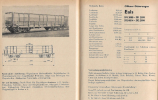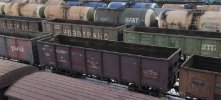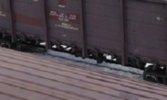You are using an out of date browser. It may not display this or other websites correctly.
You should upgrade or use an alternative browser.
You should upgrade or use an alternative browser.
What car is this?
- Thread starter justme igor
- Start date
justme igor
Registered
Thanks for your effort, the time table is correct, but i tend to think this is more from the Prussian railways.
I am sorry to say:
On the aa20's cars there are no doors.
the frame where the bucket sits on is different, bogies also.
Couplers appear to be the same.
btw the drawing looks like a breaking car to me, it has a door.
Thanks
Around 1932 the Soviets had approx~507.900 cargo cars around 1938 ~644.000 pieces, just 25% was own build or rebuild.If they are of Canadian (US?) origin...
Might it be worth looking West, rather than East, for something similar? - Possibly earlier than 1930, as they might have been 'second-hand', perhaps?
All that was build by other country's was made for the Soviets on there specs, i dont think company's will hold records, let alone picture's of there builds after 90 years.
Its a long shot to google some of those cars and compare.
The Canadian wooden box car is pretty strait forward and a high selling car back then, you can find them in almost every rail road in prewar days.
First i am going to dive in the Soviets open hopper cars and their gondolas for aggregate/ore.
I made a ruf drawing of a side view of what i must look for.
Between the bogies is a big
10 against 1 it is a 40ft.
Cant wait to start building the aa20 in 1:32 would become: 1 meter 5 cm and 4 mm from center coupler to center coupler and from top track to top chimney=16.4 cm high and a educated guess 11.4 cm width beast....
Thanks for your thoughts and thinking along, it is highly appreciated.
tac foley
Registered
It is from post-WW2 Deutsche Reichsbahn - the railway system of former East Germany, the DDR.tac foley ,
Thanks for your effort, the time table is correct, but i tend to think this is more from the Prussian railways.
I am sorry to say:
On the aa20's cars there are no doors.
the frame where the bucket sits on is different, bogies also.
Couplers appear to be the same.
btw the drawing looks like a breaking car to me, it has a door.
Thanks
Around 1932 the Soviets had approx~507.900 cargo cars around 1938 ~644.000 pieces, just 25% was own build or rebuild.
All that was build by other country's was made for the Soviets on there specs, i dont think company's will hold records, let alone picture's of there builds after 90 years.
Its a long shot to google some of those cars and compare.
The Canadian wooden box car is pretty strait forward and a high selling car back then, you can find them in almost every rail road in prewar days.
First i am going to dive in the Soviets open hopper cars and their gondolas for aggregate/ore.
I made a ruf drawing of a side view of what i must look for.
Between the bogies is a big
10 against 1 it is a 40ft.
Cant wait to start building the aa20 in 1:32 would become: 1 meter 5 cm and 4 mm from center coupler to center coupler and from top track to top chimney=16.4 cm high and a educated guess 11.4 cm width beast....
Thanks for your thoughts and thinking along, it is highly appreciated.
I just included it, not because it was the exact thing you wanted, but because it was the only thing I could find that was anywhere near what you wanted. As a scratch-builder of many years experience, I am very well aware that is is different. You are going to have a VERY hard time finding out anything concerning pre-WW2 Soviet railroad car production, mainly because of the secrecy surrounding everything they did.
Last edited:
Gizzy
A gentleman, a scholar, and a railway modeller....
A version of these wagons, coded Eaos, are often used these days by DB to deliver aggregates to the Tarmac and Mick George (Mucky Micky) depots at Cambridge North. I believe they were constructed in Poland.
They are used all over Europe.
I guess you just couldn't design it any better....
justme igor
Registered
And this is the part where the fun begins(already started btw) digging out old videos, news papers, archives, railroad magazines, writing email to the factory's even one to the scrap yard....scraping the bottom of the barrel.mainly because of the secrecy surrounding everything they did.
Did not do a bad job this far...I have a strong suspicion that i accumulated more facts and details than others on the aa20, especially when i look at there builds.
Thanks again for your help and effort i did not mean to insult you or to step you down
justme igor
Registered
justme igor
Registered
guess not, just like the Canadian box car, also a very successful modelI guess you just couldn't design it any better....
justme igor
Registered
For those that are interested:
ak1508 - Professional, General Artist | DeviantArt
Judging by the comments when you clic on the photo this is the one i was searching for, except built 50/60 years earlier than those models.
Big thumb up!
ak1508 - Professional, General Artist | DeviantArt
Judging by the comments when you clic on the photo this is the one i was searching for, except built 50/60 years earlier than those models.
Big thumb up!
tac foley
Registered
Last night I emole my fellow trainists in Ottawa, and received the following replone - something there might help you along....................
Hi Bruce,
I can't answer about the 30,000 rail cars made in Canada but there are some links here about the Trans Siberian Railway and other discussion .
Mostly WW1 era
0t----Vladivostok rail-----1915 (practicalmachinist.com)
I would guess some of the other old railway journals from Canada might have some mention of contracts for them being made for Russia if they had been made here .
If they were done past the mid 1920s these magazines may not yet be available on archive.org. but maybe available in a University or Science & Tech library .
Internet Archive Search: subject:"Transportation -- Periodicals"
Canadian transportation : Free Download, Borrow, and Streaming : Internet Archive
Some Oil Take Cars shipped to Russia from Canada mentioned on this page from 1922
Hi Bruce,
I can't answer about the 30,000 rail cars made in Canada but there are some links here about the Trans Siberian Railway and other discussion .
Mostly WW1 era
0t----Vladivostok rail-----1915 (practicalmachinist.com)
I would guess some of the other old railway journals from Canada might have some mention of contracts for them being made for Russia if they had been made here .
If they were done past the mid 1920s these magazines may not yet be available on archive.org. but maybe available in a University or Science & Tech library .
Internet Archive Search: subject:"Transportation -- Periodicals"
Canadian transportation : Free Download, Borrow, and Streaming : Internet Archive
Some Oil Take Cars shipped to Russia from Canada mentioned on this page from 1922
Had a quick look through the Wikipedia list of (Canadian) rail car manufacturers and none seem to have exported to Russia (or Poland etc) between the two great wars. Doubt we/Canada exported much of anything manufactured to them in those days. Did they steal a North American design?
 en.wikipedia.org
en.wikipedia.org
List of rolling stock manufacturers - Wikipedia
kevinhammond
Registered
Not directly on topic, but a number of pre-grouping companies in the UK built bogie hopper wagons (from at least the early 1890s).
These ones were built in 1935/6 by the Southern Railway. They have straight steel sides (riveted).
These evolved into post-war standard designs in the UK. So the design is consistent with 1930s, or even earlier.
Digging a bit deeper, the Germans seem to have been producing welded wagons from about 1933 - is it possible that the Germans also built some wagons for the locomotive to haul, or just sent a few from Germany along with the locomotive? Referring to a standard class of wagon - "Many of these wagons had been designed for conversion to the Russian broad gauge because of the beginning flourishing German-Russian economic relations" Interchangeable freight wagons - zxc.wiki. They were fitted with air brakes (which would be piped), and some types were also built with steam heating pipes for use with mixed trains, including passenger carriages. I haven't yet found a picture that looks exactly like the ones above, unfortunately!
These ones were built in 1935/6 by the Southern Railway. They have straight steel sides (riveted).
These evolved into post-war standard designs in the UK. So the design is consistent with 1930s, or even earlier.
Digging a bit deeper, the Germans seem to have been producing welded wagons from about 1933 - is it possible that the Germans also built some wagons for the locomotive to haul, or just sent a few from Germany along with the locomotive? Referring to a standard class of wagon - "Many of these wagons had been designed for conversion to the Russian broad gauge because of the beginning flourishing German-Russian economic relations" Interchangeable freight wagons - zxc.wiki. They were fitted with air brakes (which would be piped), and some types were also built with steam heating pipes for use with mixed trains, including passenger carriages. I haven't yet found a picture that looks exactly like the ones above, unfortunately!
tac foley
Registered
Not directly on topic, but a number of pre-grouping companies in the UK built bogie hopper wagons (from at least the early 1890s).
These ones were built in 1935/6 by the Southern Railway. They have straight steel sides (riveted).
These evolved into post-war standard designs in the UK. So the design is consistent with 1930s, or even earlier.
Digging a bit deeper, the Germans seem to have been producing welded wagons from about 1933 - is it possible that the Germans also built some wagons for the locomotive to haul, or just sent a few from Germany along with the locomotive? Referring to a standard class of wagon - "Many of these wagons had been designed for conversion to the Russian broad gauge because of the beginning flourishing German-Russian economic relations" Interchangeable freight wagons - zxc.wiki. They were fitted with air brakes (which would be piped), and some types were also built with steam heating pipes for use with mixed trains, including passenger carriages. I haven't yet found a picture that looks exactly like the ones above, unfortunately!
By comparison with European loading gauge, most British rolling stock of the time was toy-sized, let alone the gigantic Soviet loading gauge - almost 17 feet railhead to top. How were so many cars of this size transported from wherever it was that they were built in UK? They would have been almost foot too wide anyhow?
My contact, Jim of OVAR, has come up with this lot -
Hi ,
Thanks for your replies,
I tried a couple of other searches and found a few more links about Railway material being sent to Russia .
I still didn't see anything about the cars in the original picture but I'm thinking that perhaps the components were made here and assembled in Russia perhaps in the shop and yard in Vladivostok as linked in my first email.
Here is a 1906 article about Canadian Car and Foundry in Montreal mentioned in the earlier articles.
Canadian machinery and metalworking (January-December 1906) (archive.org)
I shared the article with Old Time Trains and it may be easier to read on that site.
Old Time Trains (trainweb.org)
The Canadian Car and foundry plant was built in Thunder Bay in 1912 so some of the cars or components might have been built there as well as in Montreal particularly if they were shipped from Vancouver.
I'm not sure how many facilities C.C. & F.there were in other places across Canada .
The Thunder Bay was also used to built aircraft in WW2.
Rosies of the North by Kelly Saxberg - NFB
Canadian Car and Foundry and the Curtiss SBW Helldiver + Remembrance Day 2011 + Canada and USA Aviation Halls of Fame 2020 Inductees, Norm Avery Update | CANAV Books Blog (wordpress.com)
This picture turned up recently about C.C.& F. in Nova Scotia from WW2.
I was not aware that they had built aircraft then either.
Plane savers | Facebook
More on the Tank Cars mentioned earlier from 1921
Canadian transportation : Free Download, Borrow, and Streaming : Internet Archive
Canadian transportation : Free Download, Borrow, and Streaming : Internet Archive
Canadian transportation : Free Download, Borrow, and Streaming : Internet Archive
800 Cars of Freight at Portal to Forward to Russia
Canadian transportation : Free Download, Borrow, and Streaming : Internet Archive
Rail at Vancouver destined for Russia 1918
Canadian transportation : Free Download, Borrow, and Streaming : Internet Archive
Track improvements in Russia
Canadian transportation : Free Download, Borrow, and Streaming : Internet Archive
Railway Age Gazette
Railway age gazette. v.63 1917 Jul-Dec. - Full View | HathiTrust Digital Library | HathiTrust Digital Library
Railway age gazette. v.63 1917 Jul-Dec. - Full View | HathiTrust Digital Library | HathiTrust Digital Library
Page 816 - 1 matching term
...ZETTE Russia is seeking 30,000 to 40,000 freight cars in the United States, in addition to 10,000 in Canada. Railroads and other private buy- ers must wait indefinitely. Of freight cars the New York Central bought in the three years 38,052 for the sum of $53,762,036, or an average of $1,412.85 per c...Railway age gazette. v.63 1917 Jul-Dec. - Full View | HathiTrust Digital Library | HathiTrust Digital Library
Railway age gazette. v.63 1917 Jul-Dec. - PT Search - Full View | HathiTrust Digital Library | HathiTrust Digital Library
Catalog Record: Railway age gazette | HathiTrust Digital Library
I'd be interested to learn more if someone finds out something but I have other projects that need work so I'd better not get too carried away on this topic .
Regards,
Jim



